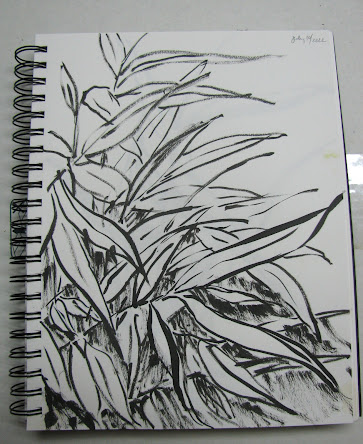Well, doesn't everyone recognize this as a finely wrought mold for shaping the elegant brick shown on the left? And it isn't blame that's in order – but rather cheers of appreciation for my friend Y, who moved to Budapest two years ago. Periodically, she sends a new image or expedition report that sets off an enthusiastic resonance. (You might remember the "Anonymus" statue – and the ladybug poster.)
Early in her explorations of Budapest's streets and buildings, Y noticed intriguing historic bricks and tracked down the Brick Museum. I'm not sure this is the very place, but scroll down for some photos and a brief English paragraph – or read onward in the text if your Hungarian is up to it! Y's photos, like this one, set the stage for my current obsession with bricks. (I'm sure Y would grant me permission to reproduce…but I want to surprise her with a "You've done it again!" moment).
Suddenly, I had a revelation:-- that among the old bricks I'd snagged from a neighbour's renovation project, I also had "trademarked" bricks – among them, some local heroes such as the "Clayburn – Made in Canada" variety (actually made near Abbotsford, BC) –
… and the "Dominion," likely made in Nanaimo, BC, -- or Saskatchewan!
On my walks, I started peering at random bricks in people's yards or at demolition sites. And voila! My best find so far (though not one I could bring home) is the elegant "Gartcraig" – a high-quality Scots-made brick that was imported to BC and elsewhere in Canada for the construction of significant buildings.
As I researched the internet, I became more and more wrapped up in the historic lore that swirls around rivers and mud and sand in the form of old-time trades and manufacturing. Consider, for example, that the same conditions that led to brickworks along rivers also led to the production of products like pottery and glass.
Here's a game you can play with unending satisfaction (well, for brick nerds). Do a Google search for "__(NAME)__ River Historic Brickworks" – plugging in any river's name you can think of in the mid-latitudes of North America or Europe. And there you are 95% sure to find accounts and photos of once-thriving brick manufacturers. I scored with Mississippi, Cooper, Delaware, Hudson, Missouri, Columbus, St. Lawrence, Thames, Shannon, Danube. Just as a whimsical test, I tried the river name I loved from my childhood in the East: Monongahela. Wow!! What a find! View the photo story here.
By this time, I'd decided to use my few old bricks in one small part of my back garden – and refer to it as The Brick Factory. Not so long ago, I would have disdained any bricks that were not, well, brick-RED – but I've become fond of the pale gold of Clayburn, which appears everywhere in the soil and stones of my yard.
Then, in the carefree mood of Summer Camp, I decided to try making a moldable melange with my clay-ish earth and an equal amount of clay mix from the craft store. Hmmm. Too much water maybe? So instead of the small figure I'd hoped to make, I slapped down a messy "brick" with the Yellow House trademark.
What a mess, but things were going better at The Brick Factory garden, and here you see its final state .
Those brick-red bricks and reddish stones were allotted their own corner.
About then, recycling day came along and, sorting papers and plastics, I came across the packaging from Purdys, Vancouver's famous chocolatier. How could I resist using this as……..a mold for mini-bricks?
Judging solely on appearance, the finished products wouldn't satisfy the quality control test – no need to move on to the taste test.
– but the universe gave me a gentle smile with an article about Purdys in the very next day's paper. (Among other things, it explains that Purdys deliberately dropped their hyphen)
Well, making bricks is no easy matter. Here's just part of the process as described in Ross King's "Brunelleschi's Dome" on the creation of Florence's cathedral Santa Maria del Fiore – a fantastic read, by the way.
It's a weighty subject, all right, and you haven't heard the last of it. (This photo is by the 20th c. photographer August Sander – more of his sometimes eeerie photos can be seen here.)




























